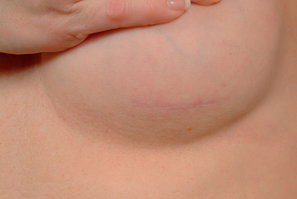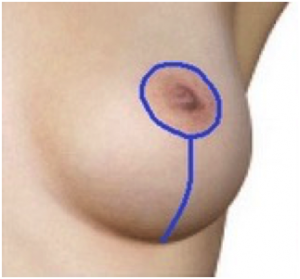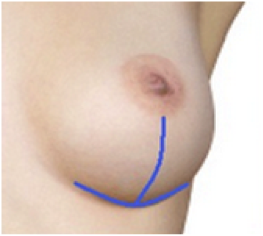Scars on the breasts can occur from a biopsy, lumpectomy, mastectomy or implants. There are many different types of scars and each scar can appear pink or red in color as well as thick or bumpy. Patients must also understand the trauma inflicted on the tissue, during a surgical procedure, can also create scarring on the inside. While scarring on the outside will fade over time, the fibrous tissue on the inside may cause lumpiness, tightness or discomfort. However, there are some ways to reduce scarring on the breasts that patients can discuss with their doctor.

Silicone Treatments
According to the American Academy of Dermatology, silicone-based bandages or sheeting can reduce the density of a scar. However, this treatment should be used daily for best results. Silicone creams and gels may also be beneficial to treat scar tissue and may be easier to apply on the breasts.
Scar Tissue Massage
Approximately 2 weeks after breast surgery, or when the incisions have healed, patients may begin massaging the scar tissue with lotion, oils or creams. Scar tissue massage can help remove built-up collagen from the surgical site for a flatter, more flexible scar. Scar massaging also alleviates lumpiness and the itchy sensation most scars have. Apply gentle pressure with two or more fingers along the scar, and in the surrounding areas, to see the best results.
Cortisone Treatments
Daily use of cortisone cream or creams containing cortisone can help shrink the size of a scar. However, the wound should be fully healed before using this type of topical medication.
Pressure Bandages
The American Academy of Dermatology states that using pressure bandages can help flatten hypertrophic scars. However, this method also requires daily use and can take several months before results are seen.
Vitamin E
Taking a daily supplement of vitamin E may help to reduce the amount of scar tissue that can form around the implant. Its powerful antioxidant abilities can repair damaged skin and fight inflammation. Vitamin E can also be found in certain oils, grains, nuts and wheat germ. It can also be found in liquid form and/or many skin care creams.
Avoid the Sun
Avoid sun exposure to new scars since the UV rays can slow the healing process and cause a dark discoloration. Furthermore, the new skin is extremely sensitive and can burn easily. Therefore, patients should apply a broad-spectrum sunscreen with SPF 15 or higher whenever going outdoors.
Laser Therapy
If a scar does not heal properly, patients may be able to reduce a scar via laser treatment. Laser therapy works by removing the outer layers of skin to promote new cell growth and a smoother texture.
Surgically Removed
Deep scarring, which cannot be remedied with tissue massage or other methods, may need to be surgically removed. Scar tissue that becomes so bad that it squeezes the implant and causes pain, or a shifting of the implant, is called capsular contracture. The surgeon will need to excise the scar tissue and may need to replace the implant.
SP

 Patients who had surgery to increase their breast size, reduce their breast size or have undergone a mastectomy will normally see some scarring from the procedure. With most
Patients who had surgery to increase their breast size, reduce their breast size or have undergone a mastectomy will normally see some scarring from the procedure. With most  A breast lift surgery, otherwise known as mastopexy, is one of the most commonly performed cosmetic procedures for the breast. Women find it an effective method of restoring the youthful appearance of their breasts. By adjusting the position of the breasts into a higher position, this procedure reduces sagging and makes the curves of the upper body look more defined.
A breast lift surgery, otherwise known as mastopexy, is one of the most commonly performed cosmetic procedures for the breast. Women find it an effective method of restoring the youthful appearance of their breasts. By adjusting the position of the breasts into a higher position, this procedure reduces sagging and makes the curves of the upper body look more defined.  The anchor technique, also known as the keyhole or inverted T incision, involves a vertical incision from the nipple down to the bottom of the breast much like a lollipop incision. The second incision is created horizontally and runs along the breast fold, thereby creating a distinctive anchor pattern for which the technique is named.
The anchor technique, also known as the keyhole or inverted T incision, involves a vertical incision from the nipple down to the bottom of the breast much like a lollipop incision. The second incision is created horizontally and runs along the breast fold, thereby creating a distinctive anchor pattern for which the technique is named.